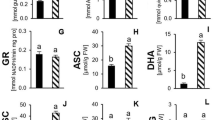Abstract
A small solute has been obtained with column chromatography, which only exists and accumulates in the leaves of dune reed in northwest China’s desert region. Its unique polyamine and aromatic features are quite different from those well-known ones accumulated under stresses. The natural quantity of the solute is strikingly proportional to the level of local high temperature, and a large section is distributed in the photosynthetic chloroplasts. Under lab conditions, we have proved that the solute plays a role in protecting or conserving chloroplasts under heat stress. So it is reasonable to suppose that the high resistance of dune reed to environmental high temperature and/or drought is at least partially due to the accumulation of this unique solute.
Similar content being viewed by others
References
Holmberg, N., Bulow, L., Improving stress tolerance in plants by gene transfer. Trends in Plant Science, 1998, 3: 61.
Bohnert, H. J., Nelson, D. E., Jensen, R. G., Adaptation to environmental stress, The Plant Cell, 1995, 7: 1099.
Galinski, E., Compatible solutes of halophilic eubacteria molecular principles, water-solutes interaction, stress protection, Experientia, 1993, 49: 487.
Potts, M., Desiccation tolerance in prokaryotes, Microbiol. Rev., 1994, 58: 755.
McCue, K. F., HanSon, A. D., Drought and salt tolerance: towards understanding and application, Trends Biotech., 1990, 8: 358.
Bartels, D., Nelson, D., Approaches to improve stress tolerance using molecular genetics, Plant Cell Environ., 1994, 17: 659.
Haslam, S. M., Variation of population types inPhragmites communis Trin., Ann. Bot., 1970, 34: 147.
Haslam, S. M., The performance ofPhragmites communis Trin, in relation to temperature, Ann. Bot., 1975, 39: 881.
Matoh, T., Matsushita, N., Takahashi, E., Salt tolerance of the reed plantsPhragmites communis Trin., Physiol. Plant, 1988, 72: 8.
Wang, H. L., Zhang, C. L., Liang, H. G., Seasonal changes of polyamines in habitat adaptation of different ecotypes of reed plants, Oecologia, 1995, 101: 119.
Mikes, O., Laboratory Handbook of Chromatographie and Allied Methods, New York: Ellis Horwood Limited, 1979, 180.
Wang, Y. J., Ye, J. Y., The protective effects pyocyanine against photoinhibition in spinach chloroplasts, Acta Phtophysio. Sinica, 1996, 22(2): 123.
Papageorgiou, G. C., Stabilization of chloroplasts and subchloroplast particles, in Methods in Enzymology (ed. Pietro, A. S.), New York: Academic Press, 1980, 69: 613.
Heckathorn, S. A., Downs, C. A., Sharkey, T. D. et al., The small, methionine-rich chloroplast heat-shock protein protects pholosystem II electron transport during heat stress. Plant Physiol., 1998, 116: 439.
Bohnert, H. J., Jenson, R. G., Strategies for engineering water-stress tolerance in plants, Trends in Biotechnology, 1996, 14: 89.
Deshnium, P., Gombos, Z., Nishiyama, Y. et al., The action of glycine betaine in enhancement of tolerance ofsyechococcus sp. Strain PCC 7942 to low temperature, J. Bacteriol., 1997, 179: 339.
Author information
Authors and Affiliations
Corresponding author
About this article
Cite this article
Pu, T., Cheng, Y. & Zhang, C. Novel compound specified in dune reed (Phragmites communis Trin.) and its possible role as a protectant on the chloroplasts under stress. Chin.Sci.Bull. 45, 2062–2067 (2000). https://doi.org/10.1007/BF03183527
Received:
Issue Date:
DOI: https://doi.org/10.1007/BF03183527




